Understanding Hunger, Eating, and Health
1/115
There's no tags or description
Looks like no tags are added yet.
Name | Mastery | Learn | Test | Matching | Spaced |
|---|
No study sessions yet.
116 Terms
To increase the probability of eating.
primary purpose of hunger?
What is the primary purpose of eating?
.purpose of eating?
What is digestion?
The gastrointestinal process of breaking down food and absorbing its constituents into the body.
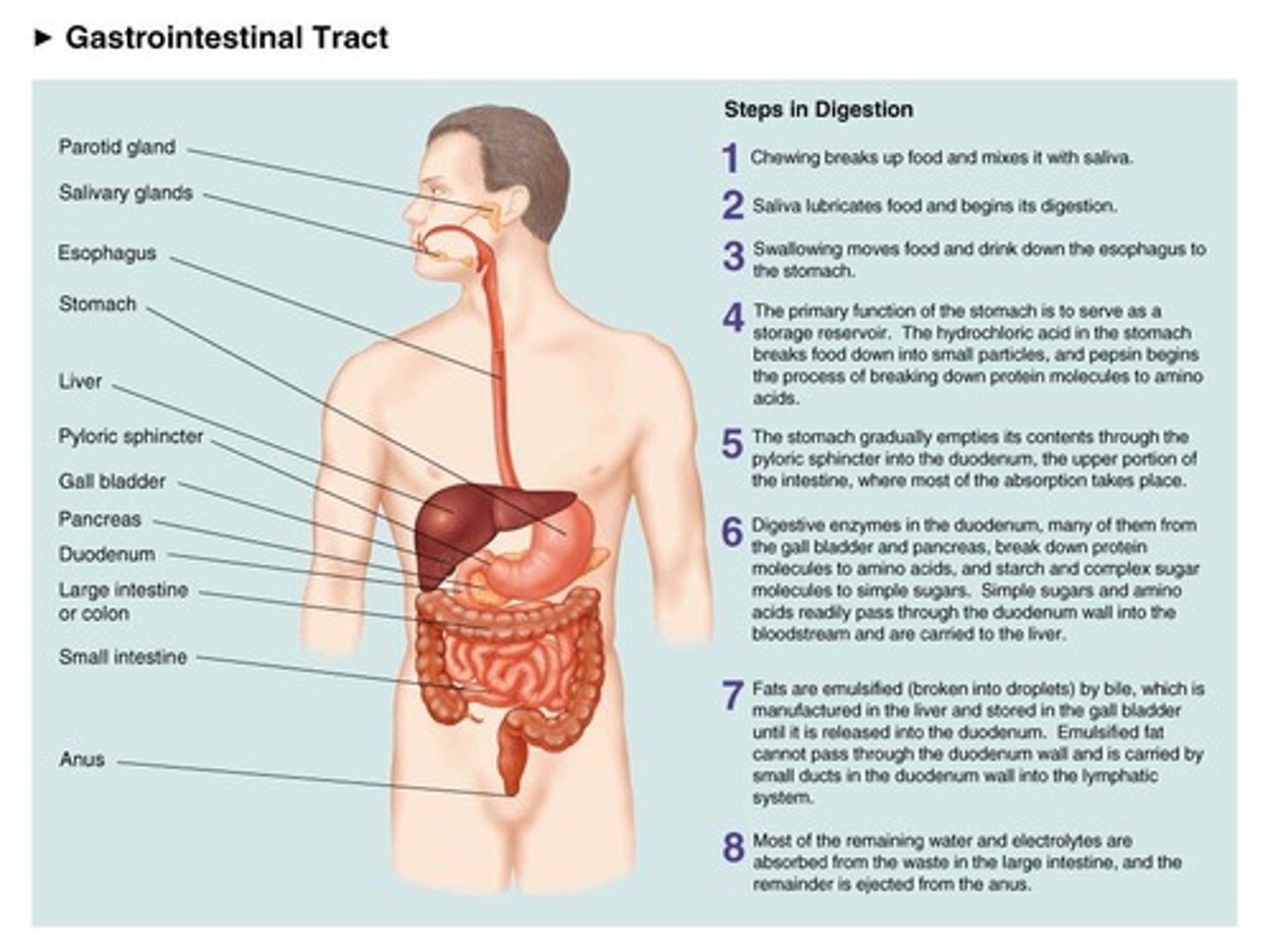
What are the three forms in which energy is delivered to the body?
Lipids (fats), Amino Acids (breakdown of proteins), and Glucose (breakdown product of carbohydrates).
Why must the body store energy?
Because energy consumption is intermittent, and the body needs energy for use in the intervals between meals.
What are the three forms in which energy is stored in the body?
Fats, proteins, and glycogen.
Which form of energy storage is most efficient?
Fats.
How much energy does one gram of fat store compared to one gram of glycogen?
One gram of fat stores twice as much energy as one gram of glycogen.
What are the three phases of energy metabolism?
Cephalic phase, Absorptive phase, and Fasting phase.
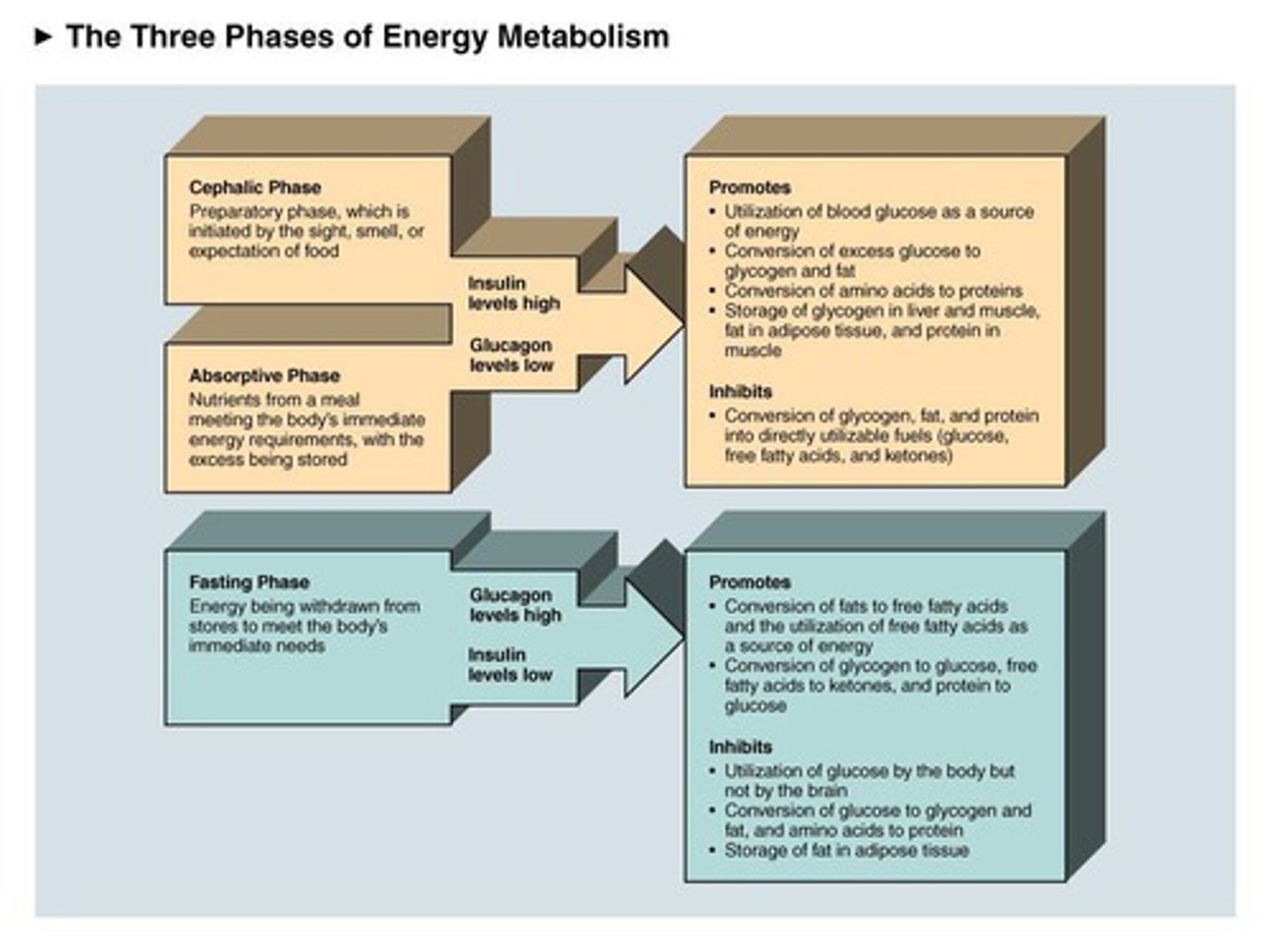
What occurs during the cephalic phase of energy metabolism?
It is a preparatory phase triggered by the sight, smell, or thought of food until intake.
What happens during the absorptive phase of energy metabolism?
Energy is absorbed into the bloodstream.
What is the fasting phase of energy metabolism?
The phase where all stored energy is used and energy is withdrawn from reserves.
What hormone is high during the cephalic and absorptive phases?
Insulin.
What does insulin trigger in the body?
It triggers glucose use as fuel, conversion of blood-borne energy to fat, glycogen, and protein, and energy storage in adipose cells, liver, and muscles.
What hormone is high during the fasting phase?
Glucagon.
What does glucagon trigger in the body?
It triggers the conversion of stored energy to usable fuel, such as fat to free fatty acids and ketones, and protein to glucose.
What is gluconeogenesis?
The conversion of protein to glucose.
What is the Set-Point Assumption regarding hunger?
Hunger is a response to an energy need; we eat to maintain an energy set point.
What are the three components of set-point systems?
Set-point mechanism, Detector mechanism, and Effector mechanism.
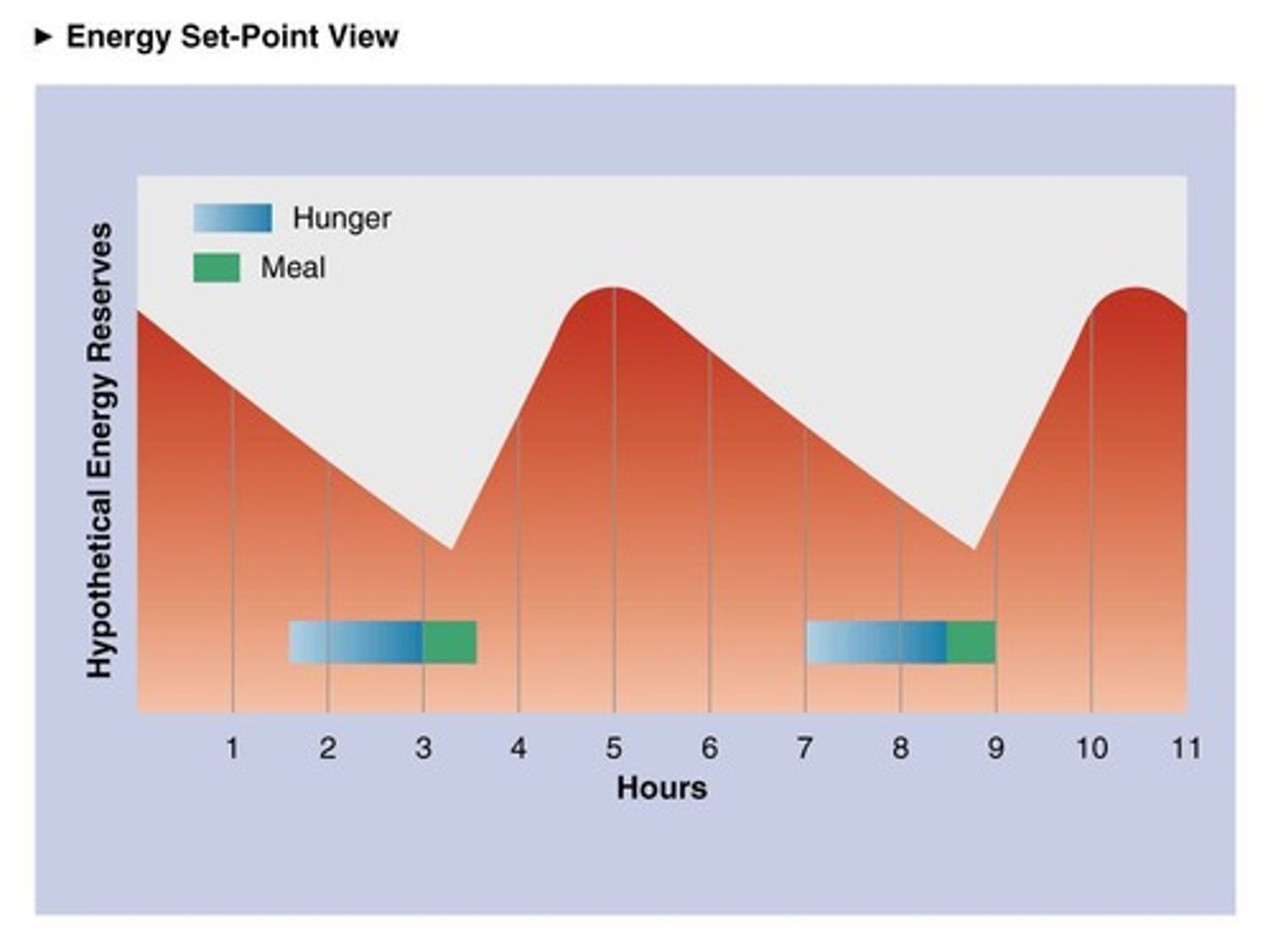
How does the typical assumption describe the function of eating in relation to energy needs?
Eating works like a thermostat, a negative feedback system that turns on when energy is needed and off when the set point is reached.
What do glucostatic and lipostatic set-point theories suggest about hunger?
We become hungry when our blood glucose levels drop significantly below their set point and become satiated when eating returns our blood glucose levels to their set point.
What percentage of the adult population in the U.S. meets clinical criteria for obesity?
Over half.
What percentage of U.S. adolescents suffer from anorexia or bulimia?
3%.
What is the main purpose of eating according to glucostatic theories?
To defend a blood glucose set point, as glucose is the brain's primary fuel.
What do lipostatic theories suggest about body fat and eating?
Deviations from body fat's set point lead to compensatory adjustments in eating to return body fat to its set point.
What phenomenon do set-point theories of hunger fail to explain?
The epidemic of obesity and overweight.
What evolutionary pressures contradict set-point theories of hunger?
Pressures that favored energy storage for survival.
What do reductions in blood glucose or body fat fail to reliably induce?
Eating.
What external factors influence eating and hunger that set-point theories do not account for?
Taste, learning, and social influences.
What does the positive-incentive perspective suggest about why we eat?
We are drawn to eat by the anticipated pleasure of eating rather than internal energy deficits.
What factors interact to determine the positive-incentive value of eating?
Flavor of the food, time since last meal, type and quantity of food.
What are adaptive species-typical preferences in relation to food?
Preferences for sweet and fatty foods due to their high energy and nutrient content.
What are adaptive species-typical aversions?
Aversions to bitter foods, which are often associated with toxins.
How do learned taste preferences and aversions develop in animals?
Animals prefer tastes followed by calorie infusion and avoid tastes followed by illness.
What happens when an animal is sodium deficient?
It develops a strong preference for the taste of sodium salt.
How do dietary deficiencies influence food selection in animals?
Animals learn to consume foods rich in missing nutrients by experiencing positive health effects.
Why is dietary deficiency still prevalent despite preferences for nutritious food?
Preferred foods often lack many nutrients, leading to maximized profits.
What influences the number of times humans eat each day?
Cultural norms, work schedules, family routines, personal preferences, and wealth.
What is the role of positive incentive value in eating behavior?
It accounts for the impact of external factors on eating behavior.
What is the relationship between energy deficits and eating according to positive-incentive theory?
Humans and animals are not driven to eat by energy deficits but by the pleasure of eating.
What is one reason why adult weight tends to be constant?
The regulation of eating through lipostatic theories maintains body fat at a set point.
What is a major criticism of set-point theories of hunger?
They do not account for the influence of external factors on eating behavior.
What are the two patterns of results regarding dietary deficiencies and food preferences?
Immediate preference for deficient nutrients and learning to consume foods rich in missing nutrients.
What do most people tend to do regarding their meals?
Most people tend to eat a few large meals each day at regular times.
What are regular mealtimes associated with?
Regular mealtimes are the same times at which a person is likely to feel most hungry.
What can happen if a person misses a regularly scheduled meal?
They may experience attacks of malaise, including headache, nausea, and inability to concentrate.
What is premeal hunger?
Premeal hunger occurs when the body enters the cephalic phase, preparing for food intake.
What causes mealtime hunger?
Mealtime hunger is caused by the expectation of food, not by an energy deficit.
What is Pavlovian conditioning of hunger?
It refers to the conditioning of eating behaviors, demonstrated by experiments where rats eat even after having recently completed a meal.
What is satiety?
Satiety is the feeling of being full, which may stop a meal.
What signals can induce satiety?
Satiety signals can be induced by food in the gut and glucose in the blood.
What is nutritive density?
Nutritive density refers to the calories per unit volume of food, which affects dietary choices.
What is sham eating?
Sham eating is a phenomenon where the amount we eat is influenced by previous experiences with food's physiological effects, rather than the immediate effects of the food in the body.
What is the appetizer effect in relation to satiety?
Small amounts of food consumed before a meal increase hunger rather than reducing it due to the cephalic-phase response.
How does serving size affect our eating behavior?
The larger the serving size, the more we tend to eat.
What social influences can affect satiety?
Rats eat more when fed in groups, while individuals may eat less to conform to societal ideals of slenderness and avoid being labeled gluttonous.
What is sensory-specific satiety?
It refers to the decline in the positive-incentive value of similar tastes due to signals from taste receptors after consuming food.
What is the cafeteria diet and its effect on eating?
A cafeteria diet offers a varied selection of highly palatable foods, encouraging greater consumption.
What are some foods resistant to sensory-specific satiety?
Rice, bread, potatoes, sweets, and green salads.
What role do blood glucose levels play in hunger and satiety?
Blood glucose drops prior to a meal as preparation to eat, but a decrease of 50% is needed to trigger feeding.
How does premeal glucose relate to hunger?
Premeal glucose decreases seem to be a response to the intention to start eating rather than a cue to eat.
What is the myth regarding the hypothalamic hunger and satiety centers?
Experiments suggested two centers: the ventromedial nucleus (VMH) as a satiety center and the lateral hypothalamus (LH) as a feeding center.
What happens when the VMH is lesioned?
Lesions produce hyperphagia (excessive eating) and extreme obesity in rats, with a dynamic phase of excessive eating followed by a static phase of stable obesity.
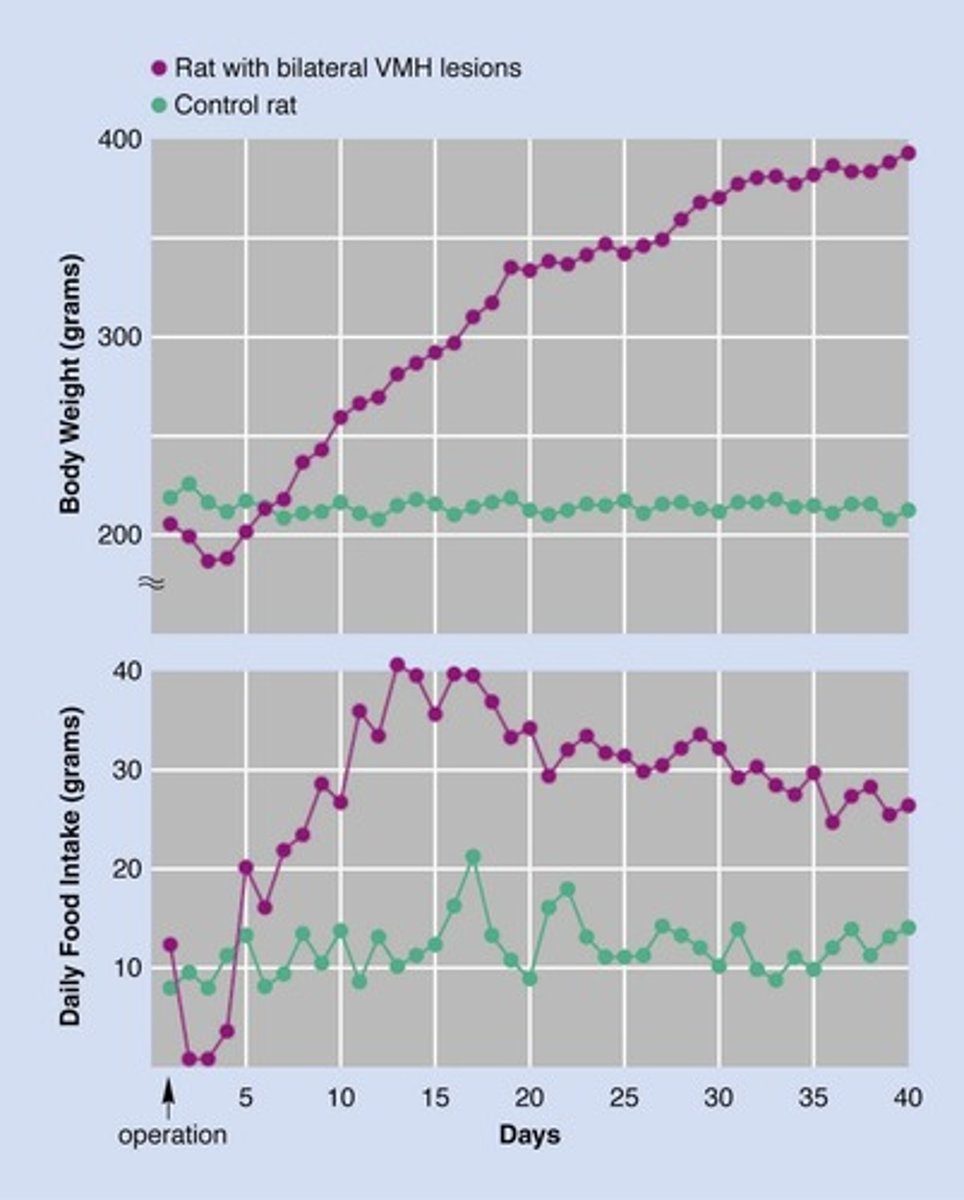
What is the likely function of the VMH according to recent findings?
The VMH is likely not a satiety center; lesions increase blood insulin levels, leading to increased lipogenesis and decreased lipolysis.
What occurs when the LH is lesioned?
Lesions produce aphagia (cessation of eating) and adipsia (cessation of drinking), but lesioned rats can recover if tube-fed.
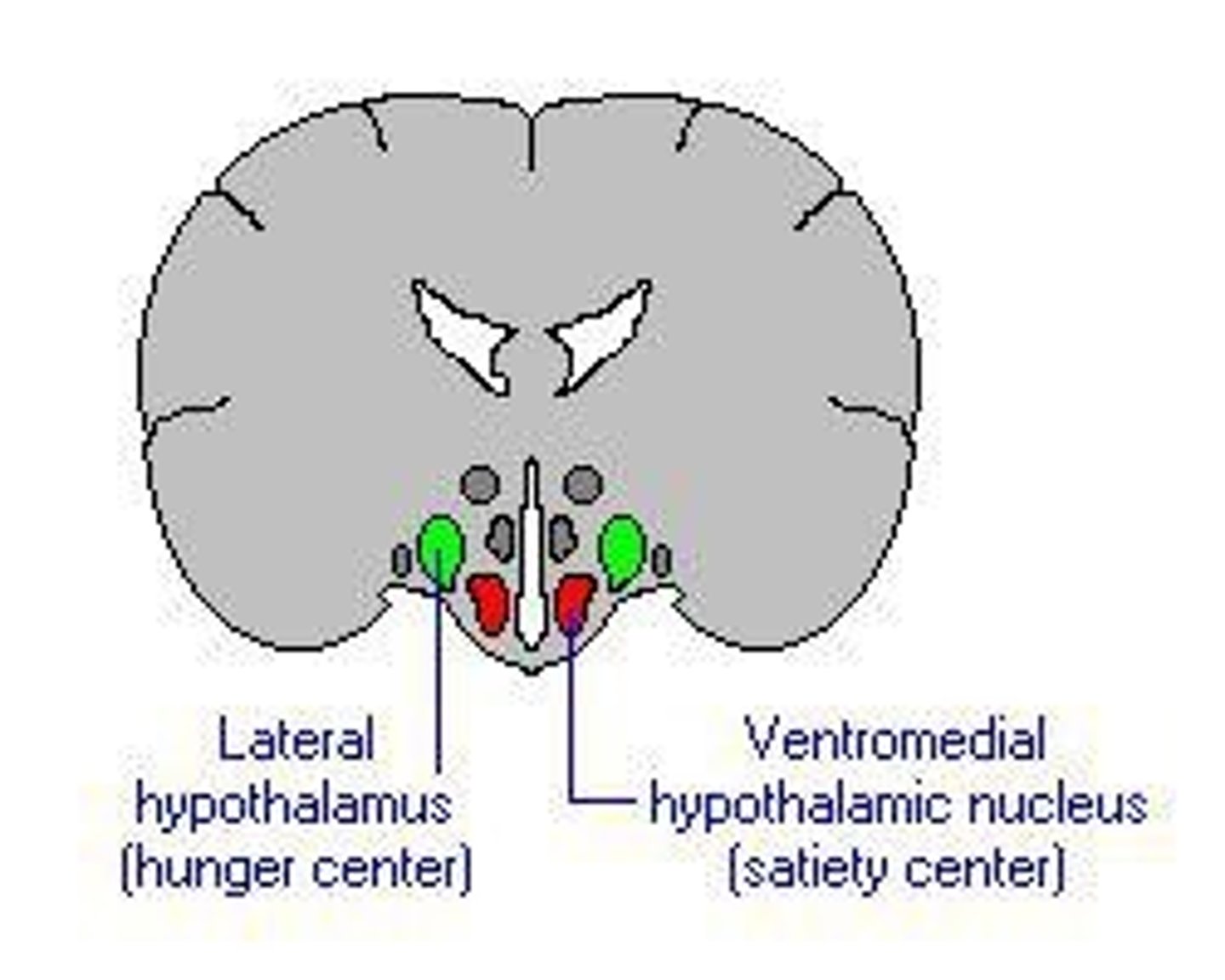
What is the most supported role of the hypothalamus?
Regulation of energy metabolism, rather than direct regulation of eating behavior.
What is the dynamic phase following VMH lesions?
It involves several weeks of grossly excessive eating and rapid weight gain.
What is the static phase following VMH lesions?
Consumption declines to a level that maintains a stable level of obesity.
How do VMH lesions affect insulin levels?
VMH lesions increase blood insulin levels, which promotes fat production.
What sensory and motor disturbances can occur with LH lesions?
LH lesions may produce disturbances that affect food-seeking behavior.
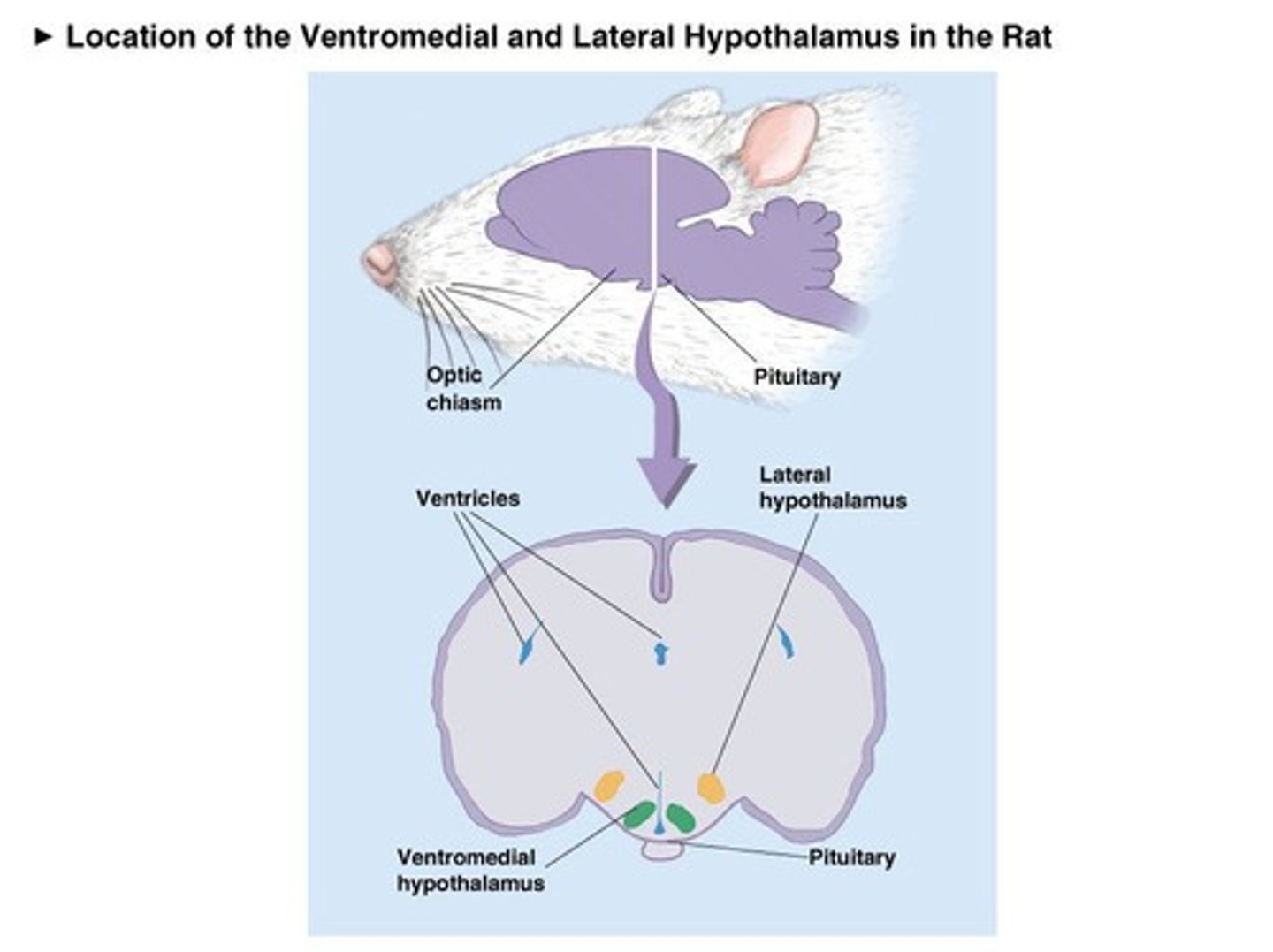
What is the relationship between reduced blood glucose and hunger?
Reduced blood glucose may contribute to hunger, but it does not prevent hunger or satiety.
What is the effect of group feeding on rats?
Rats tend to eat more when fed in groups.
How does societal pressure influence eating behavior?
Individuals may eat less to conform to societal ideals of slenderness.
What is the significance of the cephalic-phase response?
It is the body's preparatory response that occurs when anticipating food, which can increase hunger.
What did Cannon and Washburn (1912) suggest about stomach contractions and satiety?
They suggested that stomach contractions led to hunger, while stomach distension led to satiety.
What phenomenon occurs in individuals with no stomach regarding hunger?
Hunger is still experienced by people with no stomach, as long as the rest of the gastrointestinal tract remains.
What was observed in rats with a transplanted stomach and intestine regarding satiety?
Rats expressed sated behavior when food was injected, suggesting gastrointestinal satiety reaches the brain through the blood.
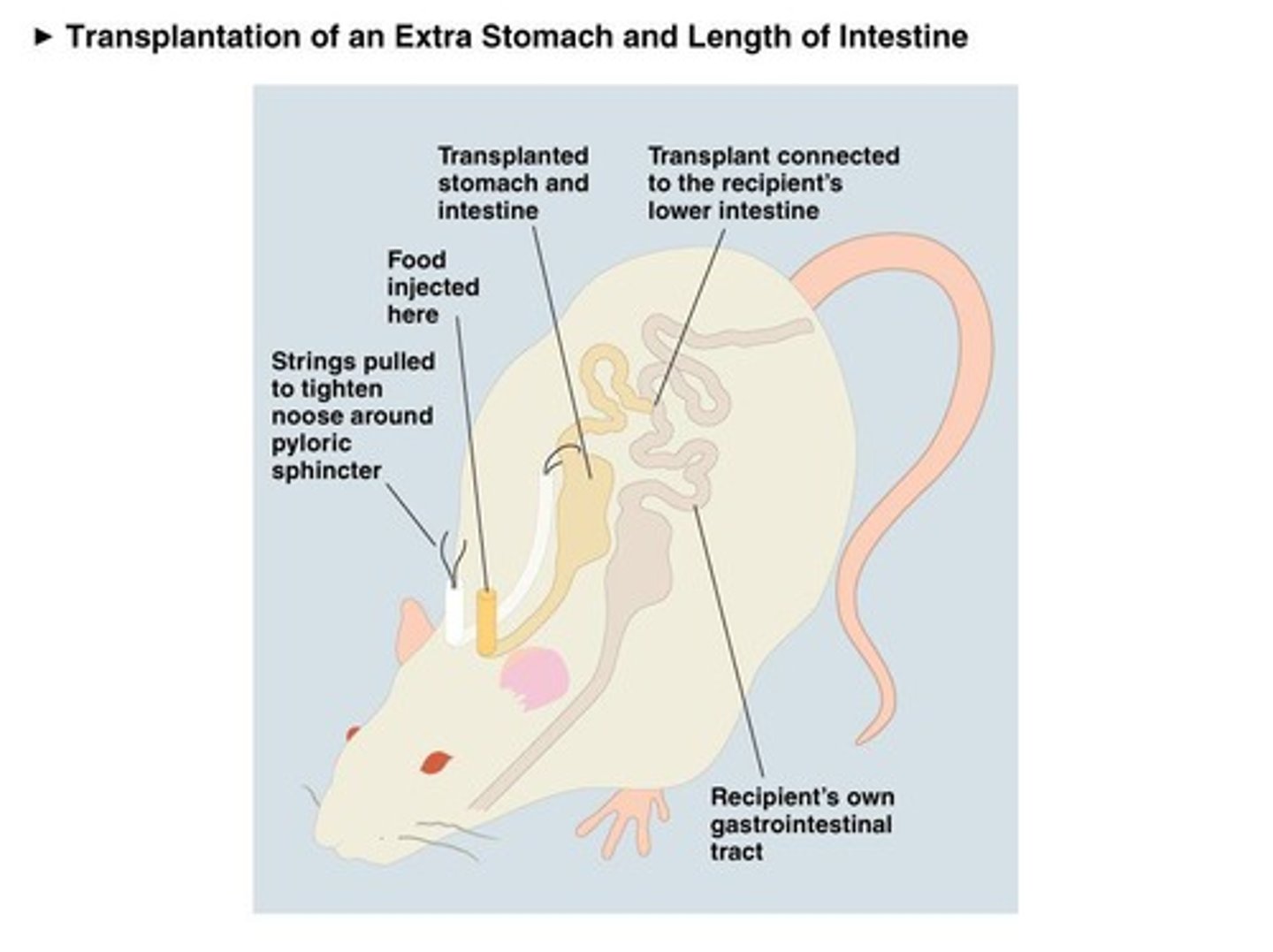
Name some gut peptides that decrease meal size.
Cholecystokinin (CCK), bombesin, glucagon, alpha-melanocyte-stimulating hormone, somatostatin.
What are hunger peptides synthesized in the hypothalamus?
Neuropeptide Y, galanin, orexin-A, ghrelin.
What central role does the hypothalamus play in eating behaviors?
The hypothalamus plays a central role in controlling various neural signals related to eating.
What effect do serotonin agonists have on food intake in rats?
Serotonin agonists consistently reduce food intake, even affecting the intake of palatable food.
How does serotonin affect food preferences?
Serotonin reduces the amount eaten per meal and shifts preferences away from fatty foods.
What are the primary symptoms of Prader-Willi Syndrome?
Insatiable appetite, extremely slow metabolism, weak muscles, small hands and feet, triangular mouth, stubbornness, feeding difficulties in infancy, tantrums, compulsivity, skin picking.
What genetic factor is associated with Prader-Willi Syndrome?
Damage or absence of a section of chromosome 15.
What can studying Prader-Willi Syndrome help us understand?
It may lead to advances in understanding eating behaviors in humans and clues about genetic factors in appetite.
What does the set-point assumption suggest about body weight regulation?
It suggests that it should be very difficult to gain weight, as hunger functions to defend the set point.
What is the effect of free-feeding on health according to the set-point assumption?
Free-feeding does not lead to optimum health, and positive effects are seen with caloric restriction.
What is diet-induced thermogenesis?
It is the mechanism by which the body adjusts the efficiency of its energy utilization in response to levels of body fat.
What is the Basal Metabolic Rate (BMR)?
The rate at which energy is utilized to maintain bodily processes when resting.
What is the natural settling point in weight control?
It is the level at which various factors influencing body weight achieve an equilibrium.
How does body fat level affect weight gain?
As body-fat level increases, changes occur that limit further increases until a balance is achieved between factors that encourage or discourage weight gain.
What does the 'leaky-barrel' model represent in weight control?
It models how body weight drifts around a natural settling point, achieving equilibrium among influencing factors.
Who should be concerned about obesity?
Everyone, as rates of obesity are increasing globally and are related to many health problems.
What statistics were reported from the NHANES 2013-2014 regarding adult obesity?
More than 1 in 3 adults were overweight, more than 2 in 3 were overweight or had obesity, and more than 1 in 3 had obesity.
What percentage of children and adolescents ages 2 to 19 were considered to have obesity according to the NHANES data?
About 1 in 6 children and adolescents were considered to have obesity.
What is the prevalence of obesity and overweight in the Philippines?
5.1 percent and 23.6 percent, according to a report by the Asia Roundtable on Food Innovation for Improved Nutrition.
What evolutionary factors contribute to the obesity epidemic?
Evolution favored high-calorie food preference, eating to capacity, fat storage, and energy efficiency.
What cultural practices contribute to obesity?
Cultural norms promote excessive eating, meals served in increasing palatability, and food as a focus of social gatherings.
What are some reasons why some people become obese while others do not?
Differences in energy input, cravings for high-calorie foods, cultural norms, large cephalic-phase responses, and differences in energy output.
What is the leaky-barrel model in relation to weight-loss programs?
It suggests that long-term weight loss requires permanent lifestyle changes.